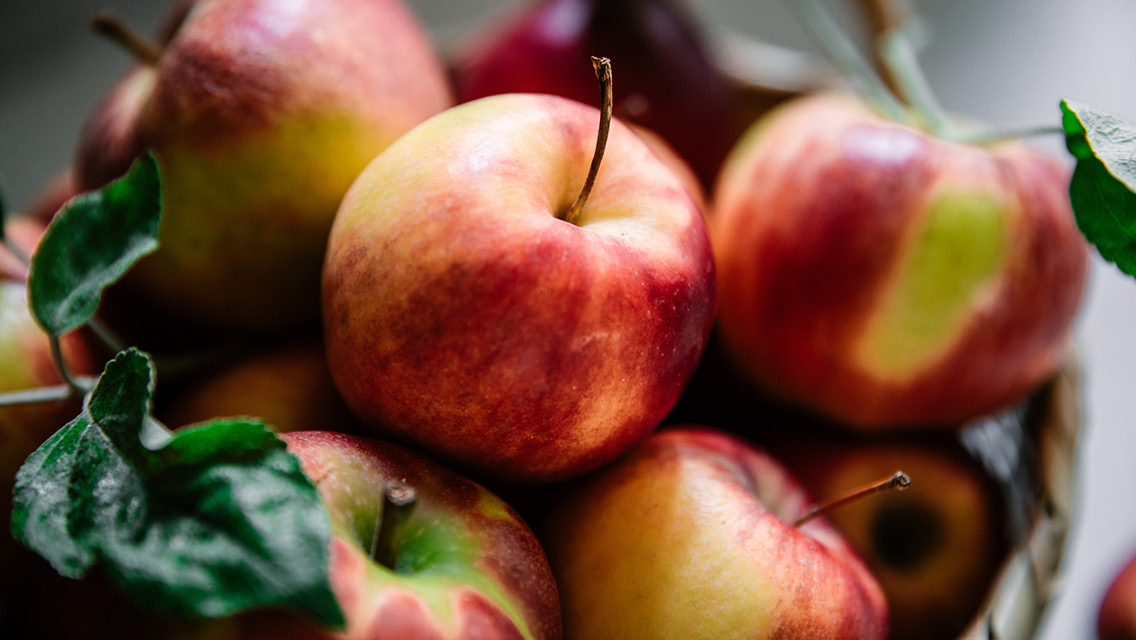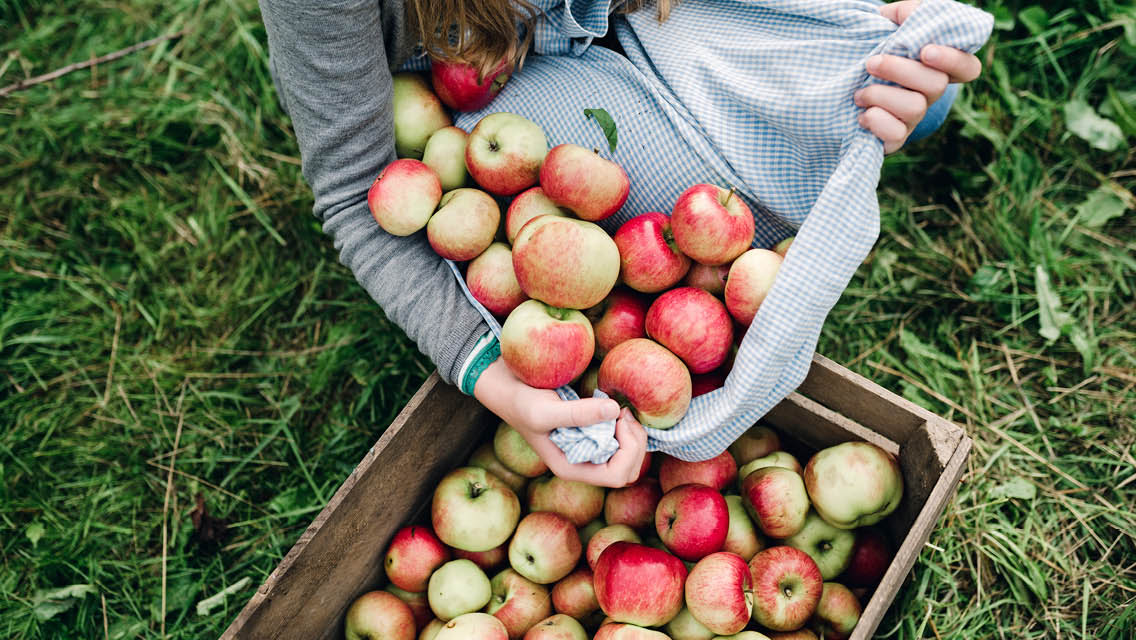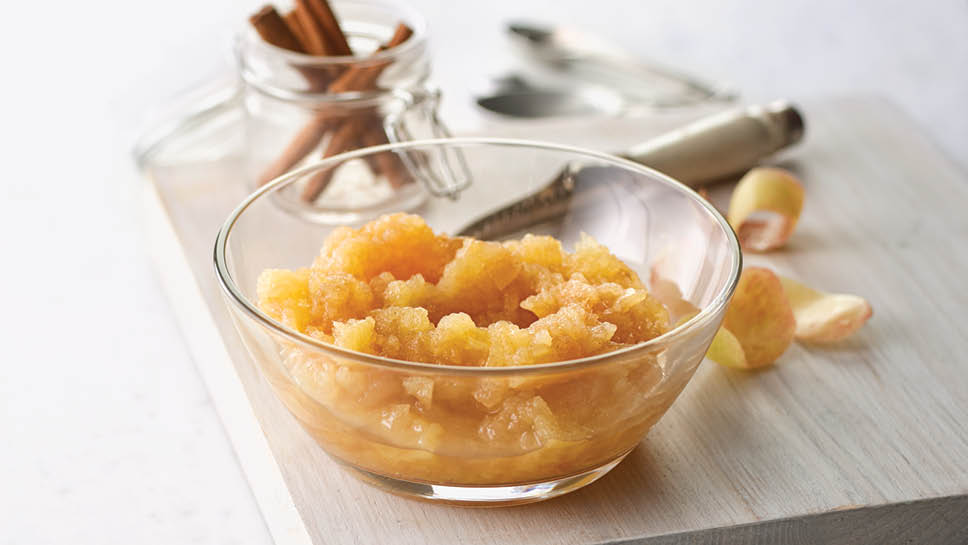Remember the old saying, “An apple a day keeps the doctor away”? There’s some basis for that: Apples are packed with healthful nutrients and fiber that help reduce the risk of cancer and heart disease. They’re also wonderfully easy to enjoy.
Food Basics
Americans gobble up this sweet, tart and juicy fruit at an annual rate of 65 apples per person. Because conventionally grown apples are subject to more pesticide spraying than almost any other food, it’s prudent to buy organic — and local — whenever possible. Organic apples are firmer and sweeter than their conventional counterparts, and the less distance a fruit has traveled, the more delectable its flavor and texture.
While more than 7,000 varieties of apples are grown around the world, only 15 varieties account for 90 percent of domestic apple production. Search your local farmers’ markets for some of those less-common, but often more flavorful, varietals, such as the fine-textured Esopus Spitzenburg or the nutty-flavored Cox’s Orange Pippen. Juicy and sweetly tart, Gravenstein apples from Sonoma County, Calif., are excellent in pies and applesauce. Find out which antique and heirloom varieties thrive in your area.
Nutritional Know-How
Apples are rich in phytonutrients such as flavonoids and phenols, and a single apple contains as much as 5 grams of fiber. Insoluble fiber helps remove LDL cholesterol from the digestive tract, and soluble fiber, called pectin, reduces the amount of LDL cholesterol produced in the liver. Pectin also helps prevent cancer by helping the body excrete toxins. Because the skin of an apple contains two-thirds of its fiber, in addition to antioxidant flavonoids and vitamin C, which also fight heart disease, it’s best to consume organic apples unpeeled. Apple peels also contain phenols, which may help prevent several chronic diseases. While apple juice can help prevent kidney stones, whole apples are best for overall health (juicing reduces phytonutrient concentrations). Look for firm apples with brightly colored skins.
Kitchen Tricks
- Always wash apples before eating them; buy organic and local whenever possible.
- To prevent cut apples from browning, rub cut surfaces with a few drops of lemon juice, or, when working with a large number of cut apples, immerse them in a four-to-one mixture of water and lemon juice.
- Store apples in a plastic bag in the coldest part of the refrigerator for several weeks or even months. Check regularly for firmness.
Eat Up!
- Take advantage of the readiness of apples year-round by adding diced, fresh apples to hot and cold cereals (or even smoothies) when fresh berries are out of season.
- For a convenient snack or bag lunch, try a crisp apple quesadilla. Slice fresh apples and place them on top of freshly ground almond butter on one half of a whole-wheat tortilla. Fold the other half of the tortilla over the apples. Place in a fry pan and brown on both sides. Cool slightly, then cut into wedges.
- Dip apple wedges into your favorite yogurt, or drizzle yogurt over apple slices. Combine a sweet variety of apple with Greek yogurt, which has a bright, tangy flavor.
- Grate fresh apples with chopped mint or cilantro, and place on top of baked or grilled fish to create a cool and appetizing “crust.” Slice, dice or shred fresh apples, and mix into green salad or slaw.
Apple-Barley Salad
Presented by Conscious Cuisine® (page 141 of book)
Makes four to five servings
Salad
- 1 cup barley
- 2 cups vegetable stock
- 1/4 cup minced fresh parsley
- 1/4 cup finely shredded fresh mint
- 1 organic Rome Beauty apple, cored and sliced
- 1 organic Granny Smith apple, cored and sliced
Dressing
- 2 tbs. fresh lemon juice
- 2 tsp. extra-virgin olive oil
- 1/4 cup unsweetened apple juice
- 1/3 cup seasoned rice wine vinegar
- 1/2 tbs. honey
- 1/8 tsp. sea salt
- Pinch freshly ground black pepper
Directions
- Toast the barley in a dry medium saucepan over medium heat. Stir constantly until lightly browned, about 3 minutes. Add the stock and bring to a boil. Cover, reduce heat, and simmer for 25 minutes, or until the barley is soft. Remove from heat and drain.
- In a mixing bowl, combine the cooked barley with the parsley, mint and apple.
- In a small bowl, whisk together the dressing ingredients. Pour the dressing over the barley mixture and toss to coat. Refrigerate for at least 30 minutes before serving.
Per serving: Calories 210; Protein 6 g; Total fat 2 g; Saturated fat 0 g; Carbohydrates 45 g; Dietary fiber 10 g; Cholesterol 0 mg; Sodium 260 mg|
Zucchini Apple Slaw
Presented by Conscious Cuisine®
Makes six servings
Salad
- 1 1/4 cups julienne yellow squash
- 1 1/4 cups julienne zucchini
- 1 1/2 cups julienne Gala apple
- 1 1/4 cups julienne carrot
- 2 tbs. chopped green onions
Dressing
- 1/4 cup white balsamic
- 2 tbs. grape seed oil
- 1 tbs. fresh minced basil
- 1/4 tsp. sea salt
- 1/8 tsp. freshly ground black pepper
Directions
- In a medium bowl, toss together the squash, zucchini, apple, carrot and green onions.
- In a separate medium bowl, whisk together the dressing ingredients and pour over zucchini mixture. Stir well to incorporate the flavors.
- Refrigerate for at least 30 minutes prior to serving.
Per serving: Calories 80; Protein 1 g; Total Fat 5 g; Saturated Fat 0 g; Carbohydrates 10 g; Dietary Fiber 2 g; Cholesterol 0 mg; Sodium 110 mg
* Use all organic vegetables and fruits, if available.
This article has been updated. It was originally published online on September 1, 2007.



This Post Has 0 Comments